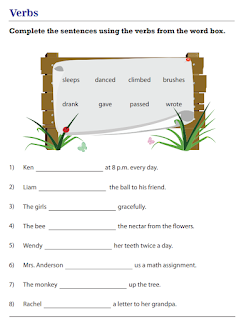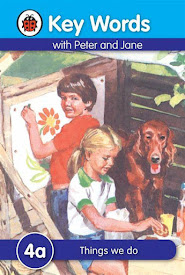Verbs and its forms Worksheets and explanation:
"Verbs and its form "
Verbs:
What is a verb?
Verbs are the action words in a sentence that describe what the subject is doing. Along with nouns, verbs are the main part of a sentence or phrase, telling a story about what is taking place. In fact, without a verb, full thoughts can’t be properly conveyed, and even the simplest sentences, such as Maria sings, have one. Actually, a verb can be a sentence by itself, with the subject, in most case you, implied, such as, Sing! and Drive!
When learning the rules of grammar, schoolchildren are often taught that verbs are ‘doing’ words, meaning they signify the part of the sentence which explains the action taking place: He ran away, she eats chocolate cake on Sundays, the horses gallop across the fields. Ran, eats and gallop are the ‘action’ parts of those sentences, thus they are the verbs. However, it can be confusing because not all verbs are easily identifiable as action: I know your name, Jack thought about it, we considered several applications. These are non-action verbs, i.e. those that describe a state of being, emotion, possession, sense or opinion. Other non-action verbs include include love, agree, feel, am, and have.
Some Example are as follows:
- Mark eats his dinner quickly.
- We went to the market.
- You write neatly in your notebook.
- They thought about all the prizes in the competition.
In the sentence Mark eats his dinner quickly, what is happening? Eating is happening, so eating is the verb.
In the sentence They thought about all the prizes what is happening? Thought (thinking) is happening, so thought is the verb.
Physical Verbs – Definition and Examples
Physical Verb Examples
The physical verb examples in the following sentences are in bold for easy identification.
- Let’s run to the corner and back.
- I hear the train coming.
- Call me when you’re finished with class.
Mental Verb – Definition and Examples
Mental verbs have meanings that are related to concepts such as discovering, understanding, thinking, or planning. In general, a mental verb refers to a cognitive state.
Mental Verb Examples
The mental verb examples in the following sentences are in bold for easy identification.
- I know the answer.
- She recognized me from across the room.
- Do you believe everything people tell you?
List of all Verb Types:
Action verbs express specific actions and are used any time you want to show action or discuss someone doing something. It’s important to remember that the action does not have to be physical.
Action verb examples:
- Run
- Dance
- Slide
- Jump
- Think
- Do
- Go
- Stand
- Smile
- Listen.
The action verb examples in the following sentences are in bold for easy identification.
I run faster than David.
He does it well.
She thinks about poetry all day long
Transitive Verbs
Transitive verbs are action verbs that always express doable activities that relate or affect someone or something else. These other things are generally direct objects, nouns or pronouns that are affected by the verb, though some verbs can also take an indirect object, such as show, take, and make. In a sentence with a transitive verb, someone or something receives the action of the verb.
Transitive verb examples:
- Love
- Respect
- Tolerate
- Believe
- Maintain.
The transitive verb examples in the following sentences are in bold for easy identification.
Gary ate the cookies.
The transitive verb is ate, Gary is the subject, because it is Gary who is doing the eating, and the cookies are the direct object, because it is the cookies that are being eaten. Other examples:
He kicked John.
John punches him.
They sold the tickets.
Examples of verbs used with both direct and indirect objects:
They sell him the tickets.
In this sentence, the tickets are the direct object while him is the indirect object.
Mary baked her mother a pie.
In this sentence, a pie is the direct object while her mother is the indirect object.
Intransitive verbs are action verbs that always express doable activities. They are different from transitive verbs because there is no direct object following an intransitive verb.
Intransitive verb examples:
- Walk
- Laugh
- Cough
- Play
- Run
The intransitive verb examples in the following sentences are in bold for easy identification.
We travelled to London.
The intransitive verb is travelled, the subject is we, because we are doing the travelling, but London is not a direct object because London is not receiving the action of the verb. Other examples:
I sneeze in the morning.
He arrived with moments to spare.
Kathryn sat away from the others.
John eats before leaving for school.
The last example shows that the verb eats can be both transitive and intransitive depending on whether there is a direct object or not. If the sentence read: John eats the cookies before leaving for school, eats would be transitive as there is a direct object – the cookies.
By the way, some verbs can be both transitive and intransitive. These verbs include: start, leave, change, live, stop.
Auxiliary verbs are also known as helping verbs and are used together with a main verb to show the verb’s tense or to form a question or negative. Common examples of auxiliary verbs include have, might, will. These auxiliary verbs give some context to the main verb, for example, letting the reader know when the action took place.
Auxiliary verb examples:
- Would
- Should
- Do
- Can
- Did
- Could
- May
The auxiliary verb examples in the following sentences are in bold for easy identification.
I will go home after football practice.
The auxiliary verb will is telling us that the action of the main verb go is going to take place in the future – after football practice has ended. If the auxiliary verb will was removed, we get the sentence:
I go home after football practice.
In this case, there is no definite time frame for the action. The sentence suggests that going home after football practice is just something the subject I generally does. Other examples:
I may dance with you later.
We did consider Bryan’s feelings.
Jenny has spoken her final words.
In addition, we can sometimes use the auxiliary very before the pronoun to make a question:
Might you dance with me later?
Did we consider Bryan’s feelings?
Has Jenny spoken her final words?
Also, auxiliary verbs are used to help form negative statements, with the use of words like not and never. These will usually split the auxiliary and main verbs:
I may never dance with you again.
We did not consider Bryan’s feelings.
Jenny has not spoken her final words.
Irregular verbs are those that don’t take on the regular spelling patterns of past simple and past participle verbs. Unfortunately, there are hundreds of irregular verbs in the English language. But don’t worry, while many are used often, the majority are not in common usage – or if they are, you will use them so often you will learn them quickly. Some of the most common irregular verbs include: say, make, go, take, come, know and see.
Irregular verb examples:
- Eat
- Think
- Bring
- Hold
- Bear
- Buy
- Lay
- Catch
- Drive
- Paid
- Feel
- Redo
The irregular verb examples in the following sentences are in bold for easy identification.
I take my time when I go to the shops (present tense)
I took my time when I went to the shops (past tense)
Julie makes cake for the classroom (present tense)
Julie made a cake for the classroom (past tense)
She sees a silhouette shaped like a man in the window (present tense)
She saw a silhouette shaped like a man in the window (past tense)
We come to Aunt Jane’s for Thanksgiving each year (present tense)
We came to Aunt Jane’s for Thanksgiving each year (past tense).
You should also remember that auxiliary verbs ‘do’ and ‘have’ are also irregular verbs:
I do agree.
He does it often.
We have done our homework early.
They do their homework on Fridays.
I have a suspicion about Fran
Fran has a devious look.
We have no money left.
They have had a cough twice this winter.
"Words like Is, am ,are ,was ,were "
The words is, am, are, was, were, help us to say something about the noun or pronoun. These words are also called Verbs. They say or tell what a person, animal or thing is. Was/were show past activity i.e. what happened in the past. We use was as the past form of am and is. We use were as the past form of are.
Look at the following sentences:
- I am a girl.
- He is a lazy boy.
- She is a teacher.
- It is a ball.
- This is her purse.
- That is his bat.
- Molly is in the kitchen
- We are sisters.
- You are late.
- These boys are hungry.
- There are many birds on the tree.
- There were ten students in the class.
- They are very rich.
- Mary and Anne are friends.
















Comments
Post a Comment